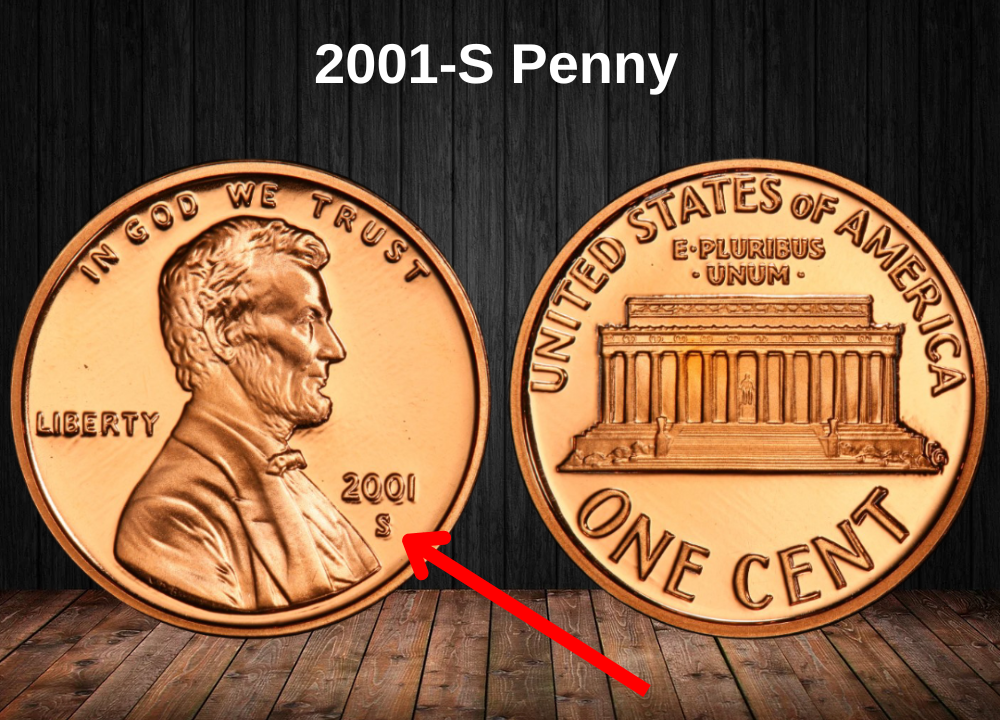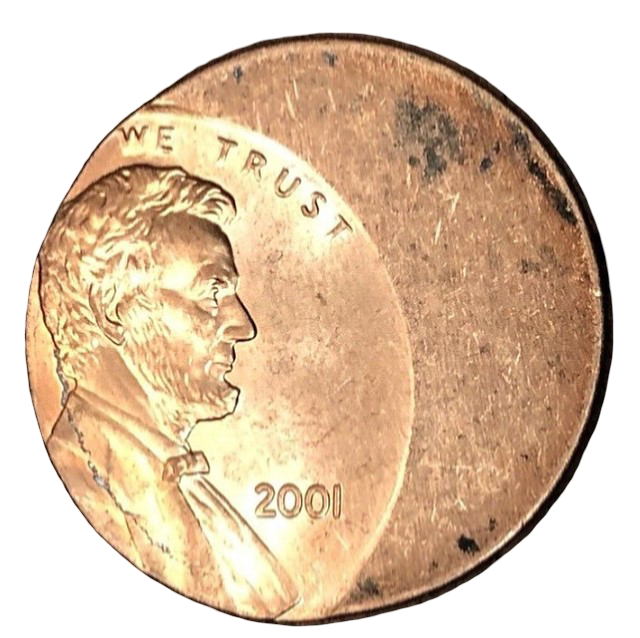Why Are Some 2001 Pennies Worth More Than Just One Cent?
Not all 2001 Lincoln pennies are ordinary — in fact, some are quite rare and valuable.
There are a few 2001 penny errors and special varieties that collectors actively seek out, and you might even find one hiding in your spare change.
But to spot a valuable 2001 penny, you need to know exactly what details to look for. Without this knowledge, it’s easy to overlook rare pieces or get overwhelmed trying to sort through common coins.
That’s why we’ve put together this guide — to help you identify the rare 2001 pennies and give you a better shot at discovering a valuable coin right from your pocket change.

2001 Penny Value (no mintmark)
The 2001 Lincoln cent without a mintmark was produced at the Philadelphia Mint. This facility typically does not include a mintmark on its coins, which is why there’s no letter under the date.
Philadelphia, being the first U.S. Mint, has a history of issuing coins without identifying marks. So, if your 2001 penny lacks a mintmark, it’s completely normal and was most likely minted in Philadelphia.
This coin isn’t rare, and it’s not automatically valuable — nearly 5 billion were made that year. To be precise, 4,959,600,000 2001 pennies came out of the Philadelphia Mint, making it very common in circulation.
As a result, worn 2001 pennies (the kind you’d find in your pocket or a coin jar) are generally worth only their face value — just 1 cent.
That said, some 2001 pennies are worth more, especially those that are in pristine condition or feature errors.
For example:
- Uncirculated 2001 no-mintmark pennies typically sell for 10 to 30 cents.
- An especially well-preserved example graded MS69RD by Professional Coin Grading Service sold for $329 in 2016!
2001-D Penny Value (“D” Mintmark)

The 2001-D Lincoln penny was minted at the Denver Mint, which is identified by the small “D” mintmark located just below the date on the coin.
While some people may assume that a penny with a “D” mintmark is rare or highly valuable, the truth is that most 2001-D pennies aren’t worth much, mainly because so many of them were produced.
In fact, the Denver Mint struck a total of 5,374,990,000 pennies in 2001, making them extremely common. So if you come across a worn 2001-D penny, it’s usually only worth its face value — one cent.
That said, not all 2001-D pennies are only worth one cent. Some can sell for more, depending on their condition or if they have certain errors.
For example:
- A 2001-D penny in uncirculated condition (no signs of wear) is typically worth 10 to 30 cents.
- The most valuable 2001-D penny ever sold fetched $1,150 in 2008, and it was graded MS69RD by Professional Coin Grading Service (PCGS) — nearly a perfect coin!
There are also rare error varieties of the 2001-D penny, which can increase its value significantly. (More on that in the next section.)
2001-S Penny Value (“S” Mintmark)

The U.S. Mint produced a limited number of special 2001 Lincoln pennies exclusively for collectors.
These coins, known as proofs, were made using highly polished planchets and were struck twice with specially prepared dies using powerful presses. This process gives them an extremely sharp, detailed appearance with mirror-like surfaces.
All 2001 proof pennies were minted at the San Francisco Mint and can be identified by the “S” mintmark below the date.
These 2001-S proof pennies were never released into circulation. Instead, they were included in proof sets sold directly to collectors by the U.S. Mint.
- Today, you can typically buy a 2001-S proof penny for around $2 to $5 from coin dealers.
- Some top-quality examples are worth significantly more. For instance, a 2001-S penny graded PCGS PR70DCAM — the highest possible grade — sold for $863 in 2007.
List of Rare 2001 Penny Errors To Watch For
While the vast majority of 2001 pennies were minted without issues, some unusual and collectible errors did make it into circulation. It’s important to note that many odd-looking coins are simply damaged after leaving the mint, not true mint errors. But a few legitimate 2001 penny errors do exist — and they can be worth much more than face value.
Let’s take a look at the most notable 2001 penny errors and how much they’re worth:
2001 Doubled Die Penny Error
One of the most well-known coin errors is the doubled die, which occurs when the die that strikes the coin is misaligned or imprinted twice.
- While there are no major 2001 doubled die errors known that fetch hundreds or thousands, there are some minor doubled die varieties.
- These typically show light doubling in the coin’s lettering, Lincoln’s eye or bowtie, or in the Lincoln Memorial columns.
- Value: These subtle 2001 doubled die pennies are generally worth $20 to $50, depending on clarity and condition.
2001 BIE Penny Error
The BIE error is a type of die crack that forms a raised line between the letters “B” and “E” in the word “LIBERTY.” It often looks like a small capital “I” — hence the name “BIE” error.
- This error is unique to Lincoln cents and occurs due to die wear and fatigue.
- These coins are popular among collectors for their visual distinctiveness.
- Value: Depending on how noticeable the die crack is, a 2001 BIE penny is typically worth $5 to $15.
2001 Off-Center Penny Error

Off-center strike errors are among the most popular types of coin errors — and some can be quite valuable. However, not every off-center 2001 penny is worth a lot.
- Most 2001 pennies with only 1% to 3% of the design shifted are pretty common and don’t add much value.
- But if you find one that’s off-center by 10% or more, you might be holding a coin that’s worth $10 to $20 or more!
- The most valuable examples are those where around 50% of the design is missing, but the full date is still clearly visible.
Value: These dramatic off-center errors can fetch $100 or even higher, especially in excellent condition.
FAQ about the 2001 Penny
1. What is the composition of the 2001 penny?
The 2001 penny is made of 97.5% zinc with a 2.5% copper plating, consistent with pennies minted since 1982.
2. Which mints produced the 2001 penny?
The 2001 penny was minted at Philadelphia (no mint mark), Denver (“D” mint mark), and San Francisco (“S” mint mark) for proof coins.
3. Are there any known errors or varieties for the 2001 penny?
Yes, collectors have identified some error coins such as doubled dies, off-center strikes, and die cracks. None are extremely rare, but error coins can be more valuable.
4. What design does the 2001 penny feature?
The obverse has Abraham Lincoln’s portrait, and the reverse shows the Lincoln Memorial, which was the standard reverse design from 1959 to 2008.
5. How common is the 2001 penny?
The 2001 penny is very common with billions minted between Philadelphia and Denver, plus millions of proof coins from San Francisco.
6. What is the average market value of a 2001 penny?
Circulated pennies are worth face value. Uncirculated and proof coins can range from a few cents to a couple of dollars, while error coins may fetch higher prices.
7. Is collecting 2001 pennies a good investment?
Typical circulated 2001 pennies are not considered good investments, but proof coins, high-grade uncirculated coins, or error varieties can be valuable to collectors.


















































